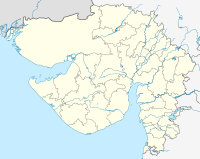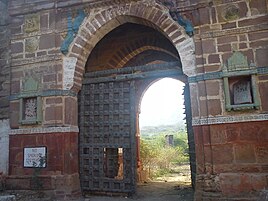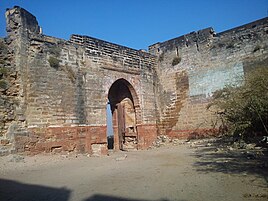
Kutch district officially spelled as Kachchh is a district of Gujarat state in western India, with its headquarters (capital) at Bhuj. Covering an area of 45,674 km2, it is the largest district of India. The area of Kutch District is larger than the entire area of states like Haryana (44,212 km2) and Kerala (38,863 km2). The population of Kutch is about 2,092,371. It has 10 talukas, 939 villages and 6 municipalities. The Kutch district is home to the Kutchi people who speak the Kutchi language.
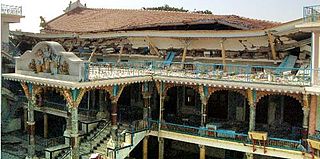
The 2001 Gujarat earthquake, also known as the Bhuj earthquake, occurred on 26 January at . The epicentre was about 9 km south-southwest of the village of Chobari in Bhachau Taluka of Kutch District of Gujarat, India.

Bhuj is a Municipality and District Headquarters of Kutch District in the state of Gujarat, India.
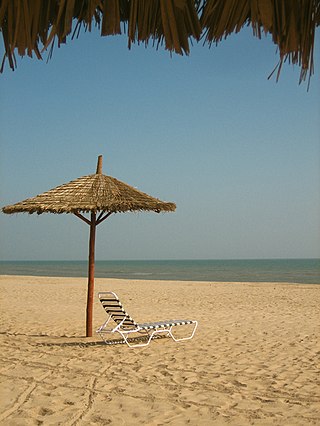
Mandvi is a Beach town with municipality in the Kutch district in the Indian state of Gujarat. It was once a major port of the region and summer retreat for Maharao (king) of the Cutch State. The old city was enclosed in the fort wall and remains of the fort wall can still be seen. The city has a four-hundred-year-old ship building industry which is still functional and dhows, a type of wooden ship, are still made. Mandvi Municipality's 36 Seat Of 9 Ward.

Naga Panchami is a day of traditional worship of Nag or snakes observed by Hindus, Jains, and Buddhists throughout India, Nepal, and other countries where Hindu, Jain, and Buddhist adherents live. The worship is offered on the fifth day of bright half of lunar month of Shravana (July/August), according to the Hindu calendar. Some Indian states, such as Karnataka, Rajasthan and Gujarat, celebrate Naga Panchami on the dark half of the same month. As part of the festivities, a Naga or serpent deity made of silver, stone, wood, or a painting of snakes is given a reverential bath with milk and their blessings are sought for the welfare of the family. Live snakes, especially cobras, are also worshipped on this day, especially with offerings of milk and generally with the assistance of a snake charmer.

The Chittorgarh, also known as Chittod Fort, is one of the largest forts in India. It is a UNESCO World Heritage Site. The fort was the capital of Mewar and is located in the present-day city of Chittorgarh. It sprawls over a hill 180 m (590.6 ft) in height spread over an area of 280 ha above the plains of the valley drained by the Berach River. The fort covers 65 historic structures, which include four palaces, 19 large temples, 20 large water bodies, 4 memorials and a few victory towers.

Hajapar is a village in Bhuj Taluka of Kachchh District of Gujarat State of India. It is located at a distance of about 18 km from Bhuj. One nearby village is Reha. As per some old records & books of Kutch Gurjar Kashtriya community Hajapar was also known as Rajapar in olden days. Rajapar is to be named after RAJAJI VARU. RAJAJI VARU was a bravest warrior and his Paliya at Jodiya town behind government high school and gita mandir. Many Paliyas are also there. The Paliyas in the memory of battle was fought for cattle herd under the leadership of RAJAJI VARU against cattle herd theft group at battlefield. RAJAJI VARU is a Surapura Dada of VARU family.
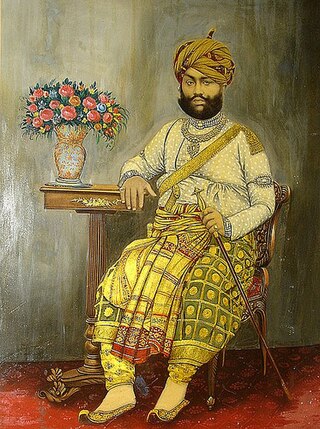
Maharao Pragmalji II, (1839−1875) was the Rao of Cutch, a ruler of Jadeja dynasty who ascended the throne upon death of his father & king Rao Deshalji II on 26 July 1860 and ruled till his death on 19 December 1875.

Koteshwar is a small village and the location of an ancient Shiva temple. It located near the mouth of Kori Creek, in the west of Kutch district of Gujarat, India.

Narayan Sarovar or Narayansar is a village and place of pilgrimage for Hindus on the Kori Creek. It is located in Lakhpat taluka of Kutch district, Gujarat, India. The ancient Koteshwar temple lies only 4 km away towards the north-west.
Tera is a historic village in the Kutch District of the Indian state of Gujarat. It is in Abdasa Taluka, located 13 kilometres (8.1 mi) from the taluka headquarters, Naliya, and 84 kilometres (52 mi) from the district headquarters, Bhuj.
Tera Fort is one of the many forts of Kutch, Gujarat, India. It is situated in southwestern Kutch near the village of Tera in Abdasa Taluka.

The siege of Golconda was a siege of Golconda Fort between the Qutb Shahi dynasty and the Mughal Emperor Aurangzeb, occuring in January 1687, lasting 8 months. The fort was home of the Kollur Mine. The Golconda Fort was considered to be an impregnable fort on the Indian subcontinent. At the end of the siege, Aurangzeb and the Mughals entered Golconda victorious.

Cutch, also spelled Kutch or Kachchh and also historically known as the Kingdom of Kutch, was a kingdom in the Kutch region from 1147 to 1819 and a princely state under British rule from 1819 to 1947. Its territories covered the present day Kutch region of Gujarat north of the Gulf of Kutch. Bordered by Sindh in the north, Cutch State was one of the few princely states with a coastline.

Jakh Botera, Jakhdada, Jakkha Bautera, 72 Yaksha or Bohter Yaksha, literally seventy-two Yaksha warriors, are group of folk deities worshiped widely in Kutch district of Gujarat, India.
Rao Deshalji I was the Rao of Cutch belonging to Jadeja Rajput dynasty, who ruled Princely State of Cutch as a regent from 1718 1752. His son Lakhpatji confined him in 1741 and ruled as a regent until death of Deshalji in 1752.
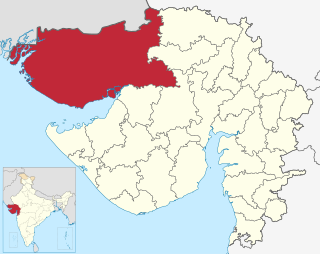
The history of Kutch, a region in the extreme west of the western Indian state of Gujarat, can be traced back to prehistorical times. There are several sites related to Indus valley civilization in region and is mentioned in Hindu mythology. In historical times, Kutch is mentioned in Greek writings during Alexander. It was ruled by Menander I of Greco-Bactrian Kingdom which was overthrown by Indo-Scythians followed by Maurya Empire and Sakas. in the first century, it was under Western Satraps followed by Gupta Empire. By fifth century, Maitraka of Valabhi took over from which its close association with ruling clans of Gujarat started. Chavdas ruled the eastern and central parts by seventh century but then came under Chaulukyas by tenth century. After fall of Chaulukya, Vaghelas ruled the state. Following conquest of Sindh by Muslim rulers, Rajput Samma started moving southwards to Kutch and ruled western regions initially. By tenth century, they controlled significant area of Kutch and by thirteenth century they controlled whole of Kutch and adopted a new dynastic identity, Jadeja.

The Battle of Bhuchar Mori, also known as Battle of Dhrol, was fought between the army of Kathiawar led by Nawanagar State and the Mughal army at Bhuchar Mori plateau near Dhrol, Saurashtra. It was meant to protect Muzaffar Shah III, the last Sultan of Gujarat Sultanate who had taken asylum under Jam Sataji of Nawanagar after his escape from the Mughal emperor Akbar. It was fought in July 1591. The Kathiawar army included the armies of Junagadh and Kundla who betrayed Nawanagar and joined the Mughal army at last. The battle led to a large number of casualty on both sides. The battle resulted in the victory of the Mughal army.

Bhujia Hill or Bhujiyo Dungar is a hill located in the outskirts of the town of Bhuj in the district of Kutch, Gujarat, India. The Bhujia Fort built on the hill overlooks the town.

The last two Gujarat Sultans, Ahmad Shah III and Mahmud Shah III, were raised to throne when they were young so the nobles were ruling the Sultanate. The nobles divided territories between themselves but soon started fighting between themselves for supremacy. One noble invited the Mughal emperor Akbar to intervene in 1572 which resulted in the conquest of Gujarat by 1573 and Gujarat becoming the province of the Mughal Empire.

